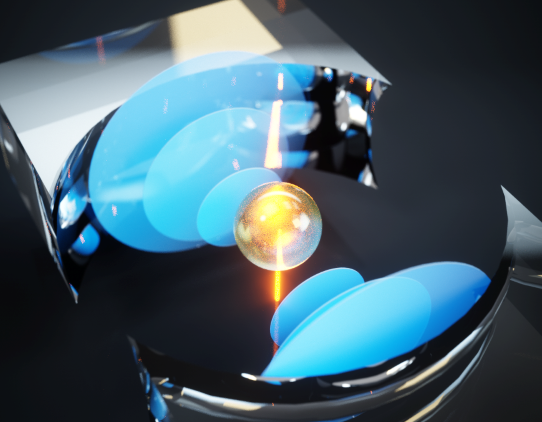 Maths, Physics & Chemistry
Maths, Physics & Chemistry
Cooled to the Quantum Realm
One of the biggest questions of our time is how gravity and quantum mechanics interact. We have achieved a long-sought-after step towards this goal by laser cooling a solid object.

Levitation of objects sounds like magic, but it is precisely what Arthur Ashkin's optical tweezer won the Nobel Prize for in 2018. An optical tweezer amounts to an intense laser that focuses down to a very small point. Optical tweezers trap an object put at that point through strong electromagnetic forces. Using optical tweezers, scientists can levitate a variety of objects such as atoms and even tiny glass spheres to isolate them from their environment and study their behavior on a scale at which quantum mechanical effects become important.
How microscopic objects behave in this regime is an unanswered question. In our everyday life, the macroscopic objects around us have well-defined positions. On the other hand, this is not necessarily the case when we start talking about microscopic objects that are under the influence of quantum mechanics and behave more like waves. If the object's position is no longer well-defined, how does gravity respond? Imagine if the earth were in a superposition of being in multiple places at once, in which direction would you fall?
To investigate these questions, we need to build an experiment with a large enough object to detect a gravitational signal but also small enough that we can put it in a state where its position and momentum are no longer well-defined quantities. Researchers believe a solid glass nanosphere, roughly 10,000 times smaller than a grain of sand, may be large enough to satisfy the gravitational part of this challenge. Cooling this tiny glass particle down till it is in its quantum state of motion, where it acts like a wave, has been a decade long problem.
In our experiment, we succeeded in cooling the motion of this nanosphere until it started to act like a wave. We shine a laser, which consists of many light particles called photons, onto the nanosphere. When the photons bounce off of the tiny glass particle they can either give or take energy away from its motion. We use a device called an optical cavity that makes it more likely for these photons to take energy away. As a result, we can continuously decrease the nanosphere's motion until we reach the lowest amount of energy allowed by quantum mechanics. This lowest state is called the motional quantum ground state.
Using this technique, we managed to cool the nanosphere down to its motional quantum ground state. This achievement is part of an ongoing effort to extend our understanding of quantum mechanics beyond microscopic ensembles. Researchers can build upon this platform to investigate extremely weak forces that are otherwise extremely difficult to measure. While this may be a satisfying conclusion of a decade-long quest, it marks the beginning of a long journey, fraught with many challenges, as we take the next step towards studying the interaction of gravity and quantum mechanics.
Original Article:
Delić U, Reisenbauer M, Dare K, et al. Cooling of a levitated nanoparticle to the motional quantum ground state. Science. 2020;367(6480):892-895.
Edited by:
Isa Ozdemir , Senior Scientific Editor
We thought you might like
Creating the world’s fastest rotating object
Jan 21, 2019 in Maths, Physics & Chemistry | 4 min read by Rene ReimannSilencing a quantum drum
Feb 27, 2019 in Maths, Physics & Chemistry | 4 min read by David Mason , Massimiliano Rossi , Albert SchliesserA crystalline silicon string played with hours-long sustain
Feb 17, 2023 in Maths, Physics & Chemistry | 3.5 min read by Alberto BeccariMore from Maths, Physics & Chemistry
Testing gravity through the distortion of time
Sep 20, 2024 in Maths, Physics & Chemistry | 3 min read by Sveva CastelloStacking molecular chips in multiple dimensions
Aug 30, 2024 in Maths, Physics & Chemistry | 3 min read by Lucía Gallego , Romain Jamagne , Michel RickhausReversible Anticoagulants: Inspired by Nature, Designed for Safety
Jun 12, 2024 in Maths, Physics & Chemistry | 4 min read by Millicent Dockerill , Nicolas WinssingerDistance-preserving moves always keep a point fixed
May 18, 2024 in Maths, Physics & Chemistry | 4 min read by Shaula FiorelliA resonance triggers chemical reactions between the coldest molecules
Apr 5, 2024 in Maths, Physics & Chemistry | 3 min read by Juliana Park , Wonyl ChoiEditor's picks
Trending now
Popular topics


